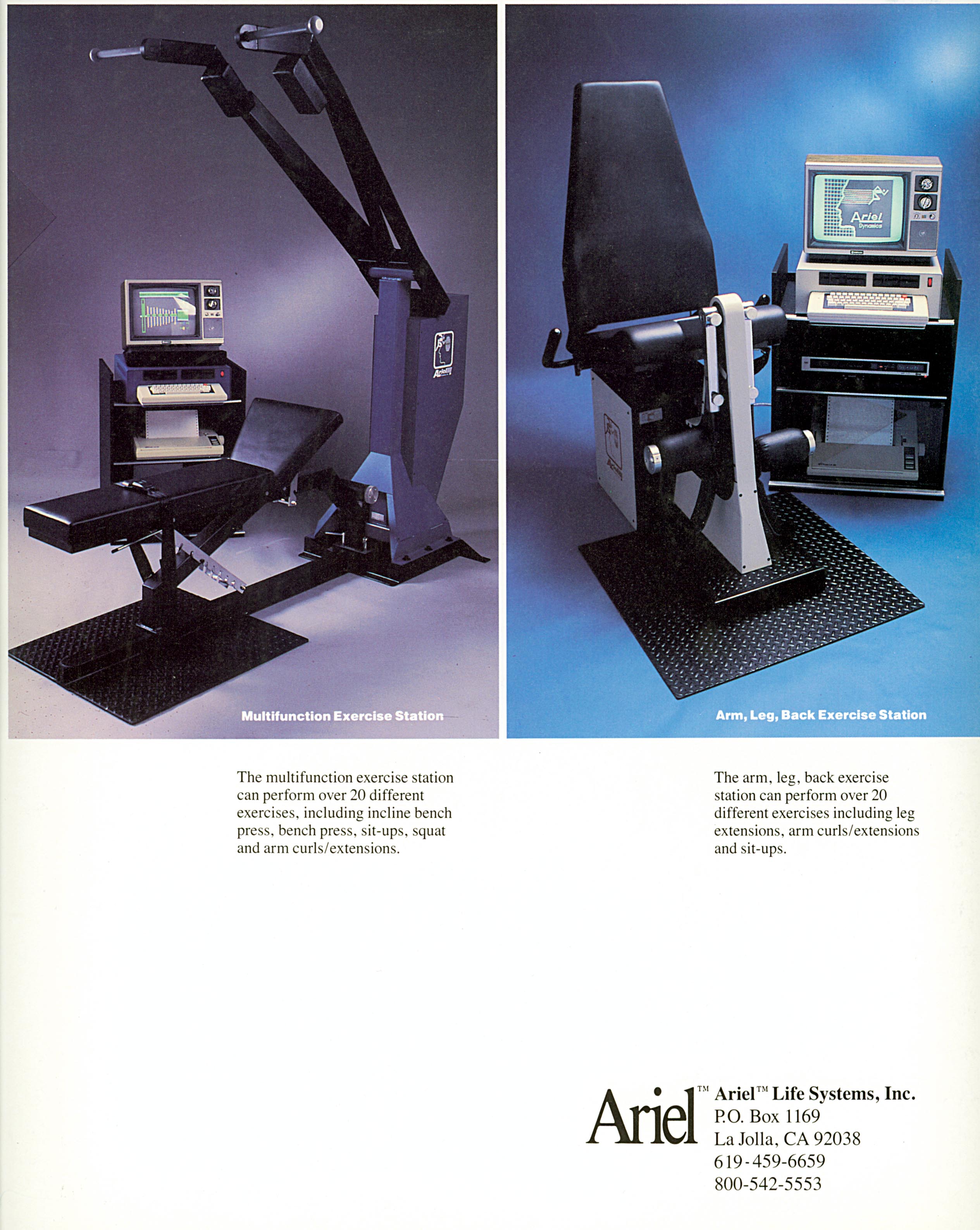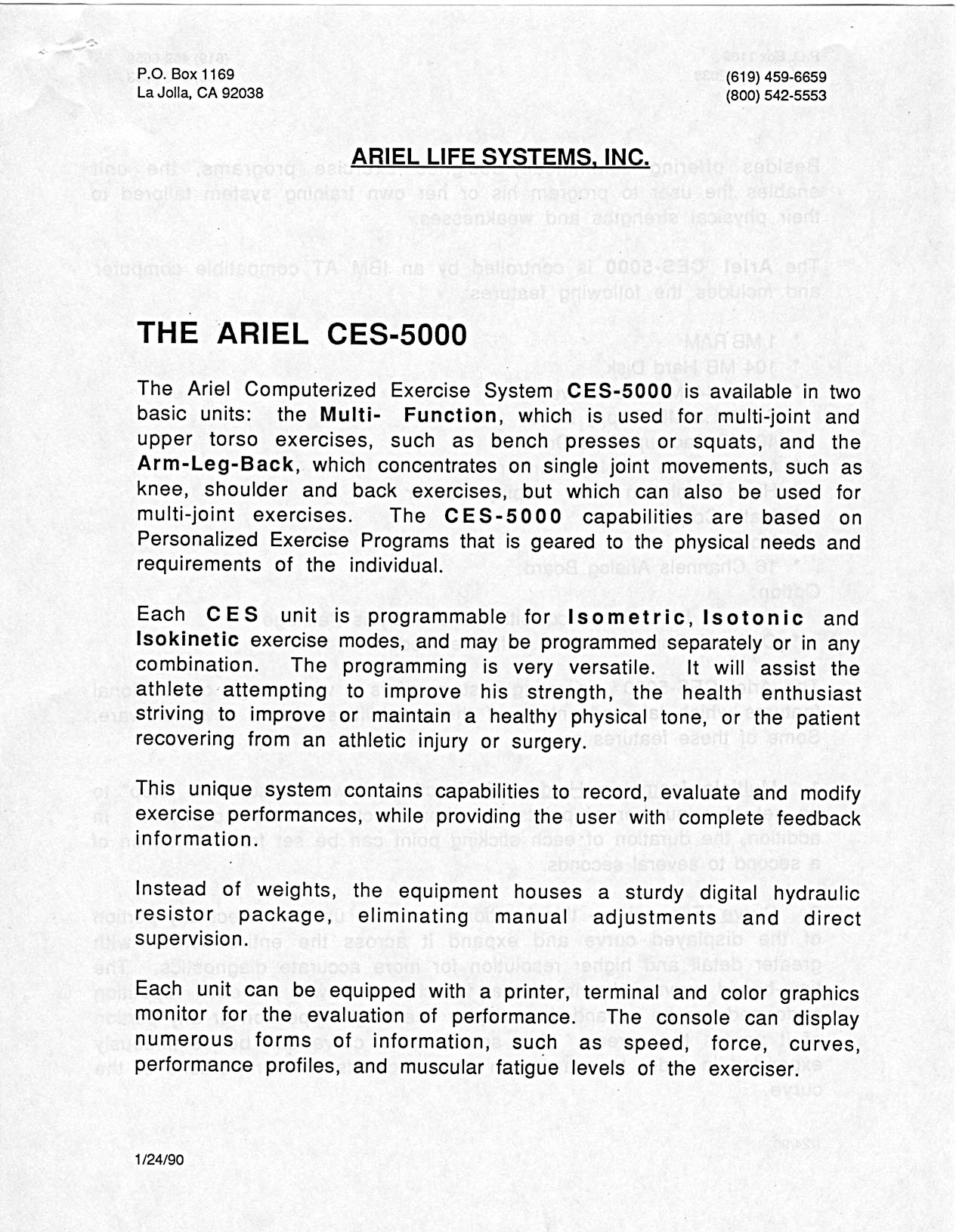Ariel Products
Brochure from 1988
By Unknown in Ariel System Brochure on Friday, January 1, 1988
The Ariel Computerized Exercise System (CES), developed by Dr. Gideon Ariel, is a state-of-the-art technology for medical diagnostics, physical therapy and rehabilitation, sports medicine evaluation and treatment, fitness training, and research. The CES automatically monitors, controls, and modifies resistance and velocity during exercise, adjusting to each person's individual capabilities and limitations. It can be used isotonically, isokinetically, and isometrically. The system records accurate measurements of movement, strength, and endurance, and can store and compare individual performance data. The CES comes in two models: the Arm Leg Machine for single joint movements and the Multi-Function Machine for multi-joint movements. The CES can perform a variety of functions, including rehabilitation and conditioning, measuring and diagnosing, recording and evaluating results, controlling and monitoring velocity and resistance, programming the range of motion, and displaying performance goals. The Ariel CES-5000 model is controlled by an IBM AT compatible computer and includes features such as a 1 MB RAM, 104 MB Hard Disk, 3.5" 1.44 MB Disk Drive, 5.25" 1.2 MB Floppy Drive, 40 MB Back-up Tape Drive, Monochrome Display Monitor, High Resolution Color Display Monitor, Math Co-processor, Mouse, and 16 Channels Analog Board Option. It also offers optional EMG Data Acquisition and Analysis Package and Curve Analysis Software Module.
Tip: use the left and right arrow keys
The Ariel Computerized Exercise System (CES), developed by Dr. Gideon Ariel a world renowned authority in biomechanics, represents the state-of-the-art in technology for medical diagnostics, physical therapy and rehabilitation, sports medicine evaluation and treatment, fitness training, and research. The Ariel CES is a computerized exercise system that automatically monitors, controls and modifies resistance and velocity, while in use. It does so safely and efficiently, constantly adjusting itself to each person's individual capabilities and limitations, and may be used isotonically, isokinetically, and isometrically. It is uniquely interactive, and the only exercise system available with so many capabilities.
The CES also records accurate measurements of movement, strength and endurance with the capacity for storage and subsequent comparison of the individual's performance.
There are two models of the CES. The Arm Leg Machine designed for single joint movements and the Multi-Function Machine designed for multi-joint movements.
What the CES Can Do
For the rehabilitation clinician as well as for the athletic trainer or Coach, the Ariel Computerized Exercise System performs many critical functions, including the ability to:
- Rehabilitate and condition
- Measure and diagnose
- Record and evaluate results
- Control and monitor velocity in each direction independently
- Control and monitor resistance in each directionindependently
- Program the pyramiding of resistance or speed in each direction
- Program the range of motion in each direction
- Accommodate resistance until the individual reaches a prescribed level of fatigue during endurance training
- Display performance goal target as an incentive during exercise
- Store and retrieve performance data
- Compare current and previous performance data in color graph, chart, or tabular form
- Generate performance profile of average and maximum exercise results for each repetition and for both up and down directions
- Illustrate in graphic format the force, work and power in relation to time, bar position, and lifting pace
- Dynamically calibrate through the entire range
ET I EEICH PRESS/PULL 00:27
Exercise results are measured and reported in up to nine different formats.
The monitor provides complete performance Information on a continuous basis during exercise. Running totals of work, repetitions, and elapsed time are maintained.
The rehabilitation curves show the measured exercise value and the bar position on a continuous basis as a function of time.
Rehabilitation statistics report, in numerical format, the average measured values for a number of parameters of exercise and motion.
Rehabilitation ratios report, in numerical format, a number of exercise performance values expressed as ratios of performance to body weight, or upstroke to downstroke.
4 The plotting and report capabilities allow the trainer, therapist, or clinician to examine and compare exercise performance data from any number of individuals and exercises. Reports are produced from exercise results saved on Individual user diskettes.
Fatigue curves report the average (solid) and maximum (red line) exercise values for the upstroke and downstroke of each repetition.
The multifunction exercise station can perform over 20 different exercises, including incline bench press, bench press. sit-ups, squat and arm curls/extensions.
The arm, leg, back exercise station can perform over 20 different exercises including leg extensions, arm curls/extensions and sit-ups.
THE ARIEL CES-5000
The Ariel Computerized Exercise System CES-5000 is available in two basic units: the Multi- Function, which is used for multi-joint and upper torso exercises, such as bench presses or squats, and the Arm-Leg-Back, which concentrates on single joint movements, such as knee, shoulder and back exercises, but which can also be used for multi-joint exercises. The CES-5000 capabilities are based on Personalized Exercise Programs that is geared to the physical needs and requirements of the individual.
Each CES unit is programmable for Isometric, Isotonic and Isokinetic exercise modes, and may be programmed separately or in any combination. The programming is very versatile. It will assist the athlete attempting to improve his strength, the health enthusiast striving to improve or maintain a healthy physical tone, or the patient recovering from an athletic injury or surgery.
This unique system contains capabilities to record, evaluate and modify exercise performances, while providing the user with complete feedback information.
Instead of weights, the equipment houses a sturdy digital hydraulic resistor package, eliminating manual adjustments and direct supervision.
Each unit can be equipped with a printer, terminal and color graphics monitor for the evaluation of performance. The console can display numerous forms of information, such as speed, force, curves, performance profiles, and muscular fatigue levels of the exerciser.
1/24/90
Besides offering scientifically-designed exercise programs, the unit enables the user to program his or her own training system tailored to their physical strengths and weaknesses.
The Ariel CES-5000 is controlled by an IBM AT compatible computer and includes the following features:
- 1 MB RAM
- 104 MB Hard Disk
- 3.5" 1.44 MB Disk Drive
- 5.25" 1.2 MB Floppy Drive
- 40 MB Back-up Tape Drive
- Monochrome Display Monitor
- High Resolution Color Display Monitor
- Math Co-processor
- Mouse
- 16 Channels Analog Board Option:
- Optional EMG Data Acquisition and Analysis Package
- Optional Curve Analysis Software Module
The Ariel CES-5000 operating system offers a wide range of additional features which take advantage of the capabilities of this new hardware. Some of these features are:
Multiple Isometric Hold - this function allows an isometric "stop" to be set at a number of points in either direction of the movement. In addition, the duration of each sticking point can be set from a fraction of a second to several seconds.
Curve Expansion - this function allows the user to select any portion of the displayed curve and expand it across the entire screen with greater detail and higher resolution for more accurate diagnostics. The time-based curves showing force, velocity, or power for each repetition performed can be expanded to display one single repetition or any portion of it across the screen. Any section of a curve can be continuously expanded in order to examine in greater details smaller portions of the curve.
1/24/90
Comparison of Time-based Curves - this function is used to display simultaneously the average curve, the time-based performance curves, and the time-based EMG curves. The user can evaluate performance and EMG data of repetitions performed with the same time-base. The curve for each repetition can be displayed as well.
Printing, - utilizing a special graphics package, the display on the color monitor, as well as any other types of output, can be directed to a variety of printers currently available.
Color Monitor, - offers a high resolution enhanced color graphics display.
User's Diskette, - User's files for testing and training can be stored on either an 80 MB hard disk or 5.25" or 3.5" floppy diskettes. Large amounts of data can be easily stored and retrieved. The 40 MB tape backup allows old or unused data to be moved from the hard disk and stored on a backup tape. The hard disk storage can be used for rapid access to current user's files. Each patient may carry a floppy disk containing his/her personal programs and data.
EMG Data Acquisition and Analysis Package (optional) - includes the following standard features:
- Up to 8 channels EMG
- High Sampling Rate
- Interface board with 8 RJ-1 1 connectors for analog input, or EMG electrodes
- EMG-analysis software package
- Preamplified surface electrodes (optional)
- Curve Characteristics Analysis (optional software module) - can be used for extended analysis of the characteristics of any force, velocity, power or EMG curves.
1/24/90







